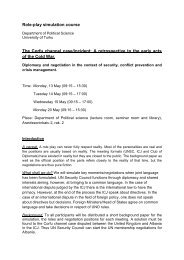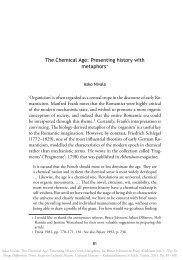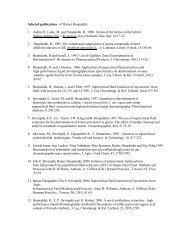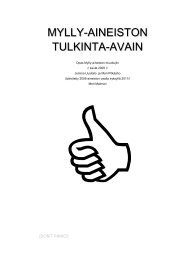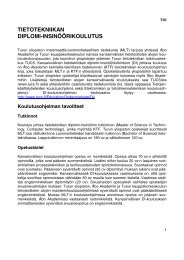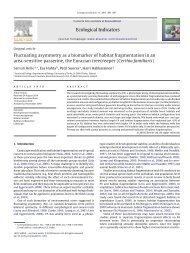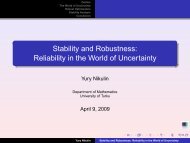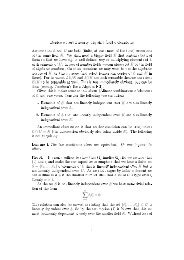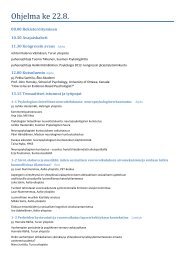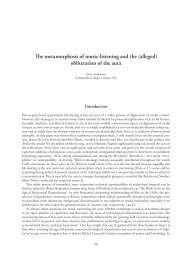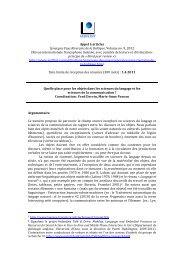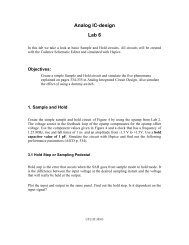MIRHAMI 2030 “Future Images of Food Consumption", Phase
MIRHAMI 2030 “Future Images of Food Consumption", Phase
MIRHAMI 2030 “Future Images of Food Consumption", Phase
Create successful ePaper yourself
Turn your PDF publications into a flip-book with our unique Google optimized e-Paper software.
SECTION II: GLOBAL REPORT SUMMARY & ANALYSIS<br />
Mirhami <strong>2030</strong><br />
cooking books can be found in bookstores located in upmarket neighborhoods. Most <strong>of</strong> them<br />
contain Indian recipes, but Italian, Mexican, Oriental, Chinese etc. cooking books are also<br />
available. They are, however, a niche category, since at home people usually do not cook by<br />
following the recipes in the books. Bookshelves at Indian homes are definitely not filled with<br />
cooking books. Cooking is learnt from one generation to another.<br />
Consciousness about healthy food and health food is increasing. Still, it is very difficult to find<br />
lowfat, lowsugar or lowsalt products in ordinary supermarkets. Healthfood segment is<br />
definitely going to increase. Alarming number <strong>of</strong> urban upper and middle class youngsters is<br />
obese. Furthermore, the consumption <strong>of</strong> saturated fats is predicted to double by <strong>2030</strong>. In 25<br />
years there will be millions adults suffering from obesity and relateddiseases – many <strong>of</strong> them<br />
since childhood. Obesity, which is already a problem, will have to be fought in a big way.<br />
On the other hand, in next few decades million <strong>of</strong> new Indian will climb up to the middleclass.<br />
Sugar and fat are still luxuries for these people, and they cannot afford to eat readytoeat food<br />
like s<strong>of</strong>t drinks, biscuits, pizzas etc. or eat out in restaurants. In <strong>2030</strong> many <strong>of</strong> them can buy<br />
these items and/or eat out in restaurants, fastfood chains etc, which still are <strong>of</strong> symbolic value.<br />
There is a risk that even tough awareness grows and obesitylevels decrease within current<br />
upper and middleclasses, the new group <strong>of</strong> people will start suffering from those.<br />
Men’s participation in household chores will be increasing when women increasingly join the<br />
labor force. Men start to do more grocery shopping and take a responsibility in cooking as well.<br />
When there is not time for cooking during the week days, cooking will appear as a hobby.<br />
Consumption <strong>of</strong> alcohol will increase. There are already signs <strong>of</strong> people’s attitudes towards<br />
alcohol consumption getting more relaxed. Additionally, young people will increasingly move<br />
out from their parents’ homes (due to work etc), and the control <strong>of</strong> family will decrease. Also<br />
the traditional family values will change. By <strong>2030</strong> local wine production most probably has<br />
taken up, it will be more common to drink wine along with the meal. Other products will also<br />
be <strong>of</strong> demand. Duties on alcohol are still extremely high, but these are expected to come down<br />
already in near future.<br />
2.3.6 Japan<br />
Background <strong>of</strong> Shokuiku (<strong>Food</strong> Education)<br />
The Basic Law defines Shokuiku as acquisition <strong>of</strong> knowledge about food as well as the ability to<br />
make appropriate food choices. Behind the law, there are a variety <strong>of</strong> food and nutrition issues<br />
such as a lack <strong>of</strong> proper concern for food; an increase in irregular and nutritionally unbalanced<br />
meals; a raise in obesity and lifestyle related diseases; an excessive desire for being slim<br />
especially among young females; outbreak <strong>of</strong> a series <strong>of</strong> incidents related to food safety; overdependency<br />
on food from abroad; and, loss <strong>of</strong> traditional food culture in a globalization<br />
movement. Some might criticize that eating is such a personal thing that government should<br />
not regulate by a law. However, Japanese situation over food had already reached to a crisis<br />
point, and that a law had to be enacted in order to address these issues.<br />
Nutritional balance Issue in Japan<br />
The Japanese dietary pattern, which consists <strong>of</strong> rice as staple, combined with a variety <strong>of</strong> other<br />
food, such as fish, meat, vegetables, fruits and milk, was formulated by around 1980. This<br />
dietary pattern was well balanced from nutritional point <strong>of</strong> view. However, today we find that<br />
the ideal dietary pattern has been totally eroded, especially among males in their thirties to<br />
sixties <strong>of</strong> age group who tend to consume excessive amounts <strong>of</strong> fat. According to the National<br />
© Finpro & Finland Futures Research Centre<br />
31




